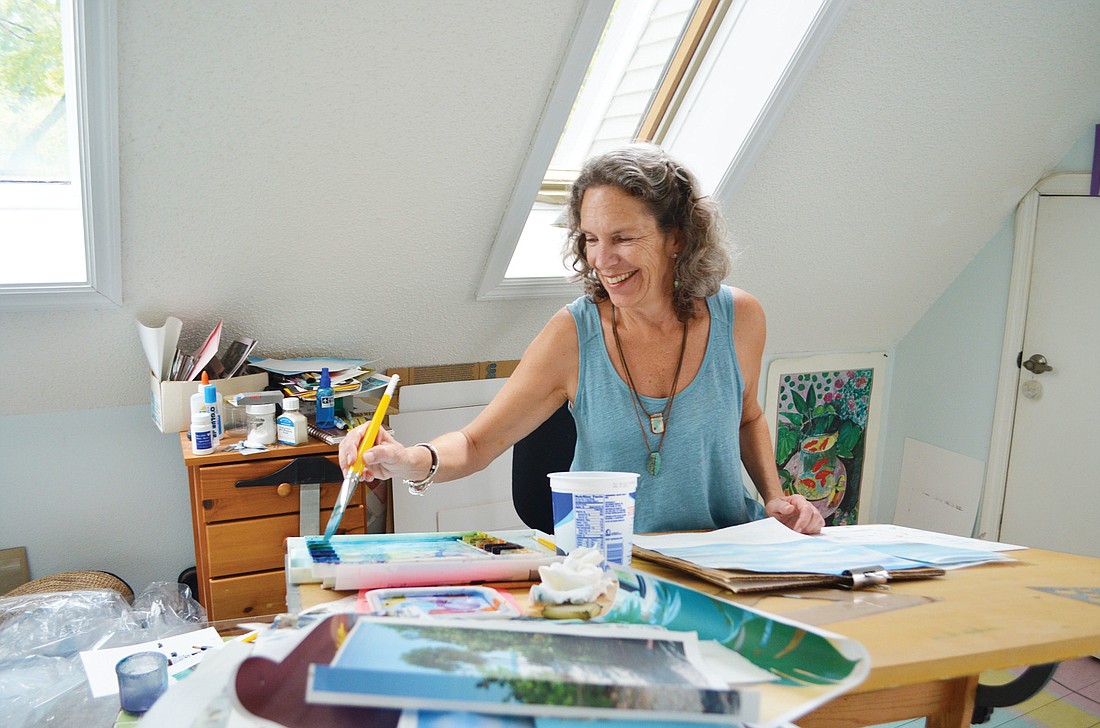- November 19, 2025
-
-
Loading

Loading

A Winslow Homer print hangs on the wall of Rita Rust’s studio. It’s a moody, marine watercolor of a boat. The dark piece is a stark opposite of the light-flooded loft studio of her home, with its cheerful robin’s egg blue-painted wooden floors where she spends her days painting barefoot.
The bohemian-dressed woman walks over and points out Homer’s strokes.
“There’s one, two, three, four — and that’s it,” she says of the water portion. “It’s so simple.”
The piece used to hang at her parents’ home when she was young. She had the same admiration for it as a little girl as she does now, a 58-year-old Sarasota-based professional watercolorist.
“I can still look at it and go, ‘Aghh,’” she says. “It’s just amazing.”
Rust remembers staring at the piece when she was a girl. She remembers that’s when it happened — that’s when she fell for watercolor.
Rust has always loved art, and though she doesn’t remember it, a childhood friend told her all she wanted to do as a little girl was paint mermaids. In high school, she never had a teacher who could demonstrate watercolor techniques. And her parents weren’t keen on her studying art in college. She took a few classes, but they never satisfied her watercolor needs — she learned the basics and drew with charcoal.
She majored in English, became a graphic artist and moved to New York. It was her way of showing her father she could make a living as an artist.
“I’m kind of stubborn in that way,” Rust says with a chuckle.
She takes a sip from a Wonder Woman coffee mug at her lace-covered dining room table. Her home is painted in calming hues of teal, and world music is playing.
There’s more of her work on the walls than the artist would like. But the economy’s downturn resulted in fewer paintings sold even though she was producing the same amount. But 2014 has been the best year for sales since pre-2008.
She explains it wasn’t until she and her husband moved to Sarasota and their daughter was in school that she decided to take a watercolor class at Ringling College of Art and Design. She can’t remember the year — it was probably the early ’90s.
Her teacher was Herbie Rose, a famous Jamaican watercolorist based north of Sarasota.
“When you see his watercolor demonstrations, you see magic,” she says of his class.
Rose used to take a group of students on trips to his native Jamaica; Rust went to Jamaica soon after her first class with Rose. Rust visited Jamaica eight times with Rose and other students and once on her own for her 50th birthday.
The group, which changed every year, stayed in an old hotel atop a mountain in Port Antonio on the northeastern coast of Jamaica. The Blue Mountains were on one side, and the blue water on the other.
She’d paint all day en plein air and swim, snorkel and climb the mountains. In the evenings, the group members would critique one another’s work.
The hotel isn’t there any more. Rose is older, and the groups no longer visit Jamaica. But the experience was instrumental in Rust’s training.
These days (but not August, because it’s too hot), she paints en plein air with the Light Chasers — a group of artists who paint landscapes around Sarasota on Thursdays. She volunteers at Art Uptown Gallery, where she’s also the exhibitions coordinator, and is a member of Florida Suncoast Watercolor Society.
Rust paints other things aside from landscapes — she has a piece she painted of a woman vendor at the Siesta Key drum circle that perfectly captures the spirit and energy of the event. But mostly, she’s drawn to nature because of the way light filters through it and shines on it.
“It’s a lot about the light,” she says.
In Nantucket, where her husband’s family has a home, the light is a little more muted than in Florida. In Illinois, where her parents live and where she spends part of her summer, the cornfields have blues and golds. But the light is most intense in Jamaica.
When she’s not outside painting, she paints from photos or sketches. Rust paints between 11 a.m. and 4 p.m. daily — but the time can vary. Occasionally, her husband, Terry McGannon, executive director of Meals on Wheels, gets home from work at 7 p.m. and she’s still busily painting.
She says the best paintings take her only four hours — the kind of painting where it’s meditative because her brain isn’t in a thinking state; there’s nothing on her mind.
“When you get in that zone,” she says, “it’s why art becomes addictive. You get in that zone and everything goes away.”